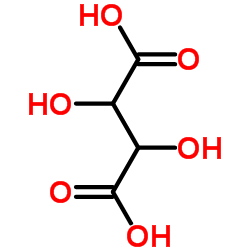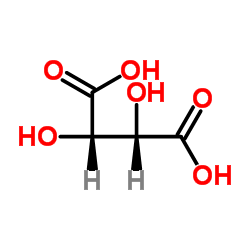815-82-7
| 中文名 | 酒石酸铜 |
|---|---|
| 英文名 | Copper(II) (2R,3R)-2,3-dihydroxysuccinate |
| 中文别名 |
2,3-二羟基-[R-(R*,R*)]-丁二酸铜(II)盐(1:1)
2,3-二羟基琥珀酸铜 2,3-二羟基-[R-(R*,R*)]-丁二酸铜盐 |
| 英文别名 |
DL-Tartaric acid
copper,(2R,3R)-2,3-dihydroxybutanedioate 2,3-Dihydroxy-succinic acid 2,3-dihydroxysuccinic acid Tartaric acid, (±)- 2,3-dihydroxybutanedioic acid Butanedioic acid, 2,3-dihydroxy- Tartaric acid Tartaric acid, (DL)- EINECS 212-425-0 MFCD00150650 |
| 密度 | 1.9±0.1 g/cm3 |
|---|---|
| 沸点 | 399.3±42.0 °C at 760 mmHg |
| 熔点 | ~275 °C (dec.)(lit.) |
| 分子式 | C4H4CuO6 |
| 分子量 | 150.087 |
| 闪点 | 209.4±24.4 °C |
| 精确质量 | 150.016434 |
| PSA | 120.72000 |
| LogP | -1.43 |
| 外观性状 | 粉末 |
| 蒸汽压 | 0.0±2.1 mmHg at 25°C |
| 折射率 | 1.586 |
| 储存条件 | 保持容器密封,储存在阴凉,干燥的地方 |
| 稳定性 | 常温常压下稳定,避免氧化物接触 |
| 水溶解性 | slightly soluble |
| 计算化学 | 1.疏水参数计算参考值(XlogP):无 2.氢键供体数量:2 3.氢键受体数量:6 4.可旋转化学键数量:1 5.互变异构体数量:无 6.拓扑分子极性表面积121 7.重原子数量:11 8.表面电荷:0 9.复杂度:123 10.同位素原子数量:0 11.确定原子立构中心数量:2 12.不确定原子立构中心数量:0 13.确定化学键立构中心数量:0 14.不确定化学键立构中心数量:0 15.共价键单元数量:2 |
| 更多 | 1. 性状:未确定 2. 密度(g/mL,25/4℃):未确定 3. 相对蒸汽密度(g/mL,空气=1):未确定 4. 熔点(ºC):~275°C (dec.)( 5. 沸点(ºC,常压):未确定 6. 沸点(ºC,5.2kPa):未确定 7. 折射率:未确定 8. 闪点(ºC):未确定 9. 比旋光度(º):未确定 10. 自燃点或引燃温度(ºC):未确定 11. 蒸气压(kPa,25ºC):未确定 12. 饱和蒸气压(kPa,60ºC):未确定 13. 燃烧热(KJ/mol):未确定 14. 临界温度(ºC):未确定 15. 临界压力(KPa):未确定 16. 油水(辛醇/水)分配系数的对数值:未确定 17. 爆炸上限(%,V/V):未确定 18. 爆炸下限(%,V/V):未确定 19. 溶解性:未确定 |
Synonym:Cupric tartrate hydrate; Butanedioic acid, 2,3-dihydroxy-(2R,3R)-, copper(2+) salt (1:1) hydrate Section 2 - COMPOSITION, INFORMATION ON INGREDIENTS
Risk Phrases: None Listed. Section 3 - HAZARDS IDENTIFICATION EMERGENCY OVERVIEW
Not available. Potential Health Effects Eye: Causes eye irritation. Skin: Causes skin irritation. May be harmful if absorbed through the skin. Ingestion: May cause irritation of the digestive tract. The toxicological properties of this substance have not been fully investigated. May be harmful if swallowed. Inhalation: Causes respiratory tract irritation. The toxicological properties of this substance have not been fully investigated. May be harmful if inhaled. Chronic: May cause liver and kidney damage. Section 4 - FIRST AID MEASURES Eyes: Flush eyes with plenty of water for at least 15 minutes, occasionally lifting the upper and lower eyelids. Get medical aid. In case of contact, immediately flush eyes with plenty of water for at least 15 minutes. Get medical aid. Skin: Get medical aid. Flush skin with plenty of water for at least 15 minutes while removing contaminated clothing and shoes. In case of contact, flush skin with plenty of water. Remove contaminated clothing and shoes. Get medical aid if irritation develops and persists. Wash clothing before reuse. Ingestion: Get medical aid. Wash mouth out with water. If swallowed, do not induce vomiting unless directed to do so by medical personnel. Never give anything by mouth to an unconscious person. Get medical aid. Inhalation: Remove from exposure and move to fresh air immediately. If inhaled, remove to fresh air. If not breathing, give artificial respiration. If breathing is difficult, give oxygen. Get medical aid. Notes to Physician: Treat symptomatically and supportively. Section 5 - FIRE FIGHTING MEASURES General Information: As in any fire, wear a self-contained breathing apparatus in pressure-demand, MSHA/NIOSH (approved or equivalent), and full protective gear. During a fire, irritating and highly toxic gases may be generated by thermal decomposition or combustion. Extinguishing Media: Use extinguishing media most appropriate for the surrounding fire. Section 6 - ACCIDENTAL RELEASE MEASURES General Information: Use proper personal protective equipment as indicated in Section 8. Spills/Leaks: Vacuum or sweep up material and place into a suitable disposal container. Clean up spills immediately, observing precautions in the Protective Equipment section. Avoid generating dusty conditions. Provide ventilation. Section 7 - HANDLING and STORAGE Handling: Wash thoroughly after handling. Remove contaminated clothing and wash before reuse. Use with adequate ventilation. Minimize dust generation and accumulation. Avoid contact with eyes, skin, and clothing. Avoid breathing dust. Storage: Store in a cool, dry, well-ventilated area away from incompatible substances. Section 8 - EXPOSURE CONTROLS, PERSONAL PROTECTION Engineering Controls: Facilities storing or utilizing this material should be equipped with an eyewash facility and a safety shower. Use adequate ventilation to keep airborne concentrations low. Exposure Limits CAS# 815-82-7: CAS# 5893-71-0: CAS# 17263-56-8: Personal Protective Equipment Eyes: Wear appropriate protective eyeglasses or chemical safety goggles as described by OSHA's eye and face protection regulations in 29 CFR 1910.133 or European Standard EN166. Skin: Wear appropriate protective gloves to prevent skin exposure. Clothing: Wear appropriate protective clothing to prevent skin exposure. Respirators: A respiratory protection program that meets OSHA's 29 CFR 1910.134 and ANSI Z88.2 requirements or European Standard EN 149 must be followed whenever workplace conditions warrant respirator use. Follow the OSHA respirator regulations found in 29 CFR 1910.134 or European Standard EN 149. Use a NIOSH/MSHA or European Standard EN 149 approved respirator if exposure limits are exceeded or if irritation or other symptoms are experienced. Section 9 - PHYSICAL AND CHEMICAL PROPERTIES Physical State: Crystalline powder Color: blue - green Odor: odorless pH: Not available. Vapor Pressure: Not available. Viscosity: Not available. Boiling Point: Not available. Freezing/Melting Point: decomposes Autoignition Temperature: Not available. Flash Point: Not applicable. Explosion Limits, lower: Not available. Explosion Limits, upper: Not available. Decomposition Temperature: Solubility in water: Slightly soluble. Specific Gravity/Density: Molecular Formula: C4H4CuO6.xH2O Molecular Weight: 211.62 Section 10 - STABILITY AND REACTIVITY Chemical Stability: Stable at room temperature in closed containers under normal storage and handling conditions. Conditions to Avoid: Dust generation, excess heat. Incompatibilities with Other Materials: Strong oxidizing agents. Hazardous Decomposition Products: Carbon monoxide, carbon dioxide, oxides of copper. Hazardous Polymerization: Will not occur. Section 11 - TOXICOLOGICAL INFORMATION RTECS#: CAS# 815-82-7 unlisted. CAS# 5893-71-0 unlisted. CAS# 17263-56-8 unlisted. LD50/LC50: Not available. Not available. Not available. Carcinogenicity: Copper(II) tartrate anhydrous - Not listed by ACGIH, IARC, or NTP. Copper(II) tartrate trihydrate - Not listed by ACGIH, IARC, or NTP. Copper(II) tartrate hydrate - Not listed by ACGIH, IARC, or NTP. Section 12 - ECOLOGICAL INFORMATION Other No information available. Section 13 - DISPOSAL CONSIDERATIONS Dispose of in a manner consistent with federal, state, and local regulations. Section 14 - TRANSPORT INFORMATION IATA No information available. IMO No information available. RID/ADR No information available. USA RQ: CAS# 815-82-7: 100 lb final RQ; 45.4 kg final RQ Section 15 - REGULATORY INFORMATION European/International Regulations European Labeling in Accordance with EC Directives Hazard Symbols: Not available. Risk Phrases: Safety Phrases: S 24/25 Avoid contact with skin and eyes. WGK (Water Danger/Protection) CAS# 815-82-7: No information available. CAS# 5893-71-0: No information available. CAS# 17263-56-8: No information available. Canada CAS# 815-82-7 is listed on Canada's DSL List. CAS# 815-82-7 is not listed on Canada's Ingredient Disclosure List. CAS# 5893-71-0 is not listed on Canada's Ingredient Disclosure List. CAS# 17263-56-8 is not listed on Canada's Ingredient Disclosure List. US FEDERAL TSCA CAS# 815-82-7 is listed on the TSCA inventory. CAS# 5893-71-0 is not on the TSCA Inventory because it is a hydrate. It is considered to be listed if the CAS number for the anhydrous form is on the inventory (40CFR720.3(u)(2)). CAS# 17263-56-8 is not on the TSCA Inventory because it is a hydrate. It is considered to be listed if the CAS number for the anhydrous form is on the inventory (40CFR720.3(u)(2)). SECTION 16 - ADDITIONAL INFORMATION N/A |
|
生态学数据: 对水是稍微有害的,不要让未稀释或大量的产品接触地下水,水道或者污水系统,若无政府许可,勿将材料排入周围环境
|
| 安全声明 (欧洲) | S24/25 |
|---|---|
| 危险品运输编码 | UN 9111 |
| WGK德国 | 3 |




